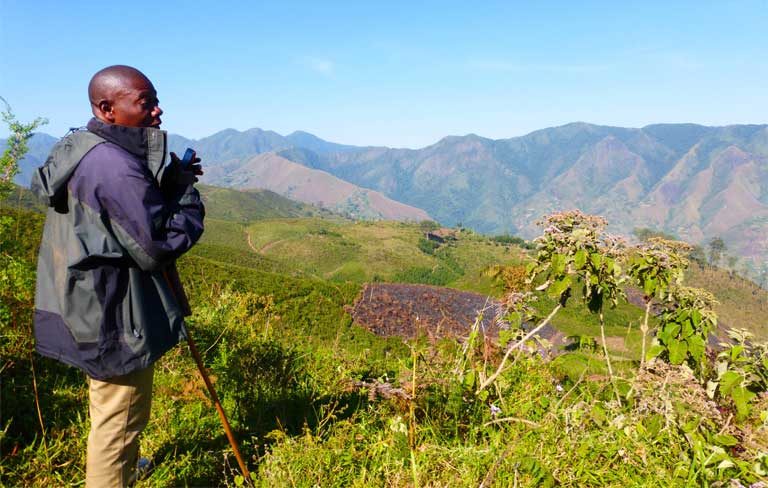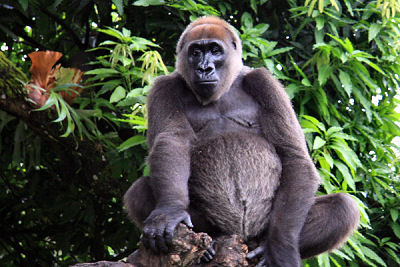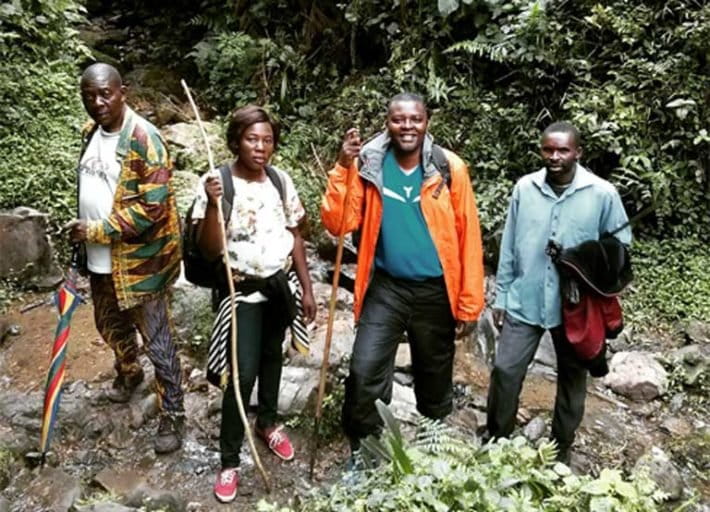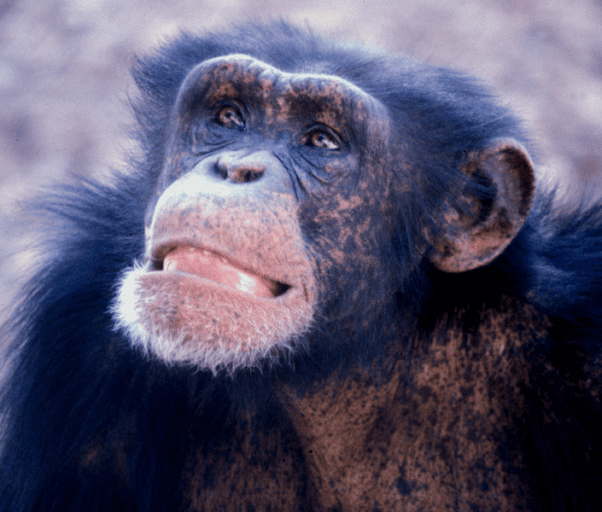- Deforestation and hunting continue to put Africa’s great apes at risk. National parks and other top down strategies have met with limited success. Many conservationists are trying alternative strategies, especially harnessing the power of indigenous taboos and other traditional knowledge to motivate local communities to protect great apes.
- In remote parts of Africa, taboos against hunting have long helped conserve gorilla populations. However, those ancient traditions are being weakened by globalization, modernization and Christianity, with anti-hunting taboos and other traditional beliefs being abandoned at a time when they are most needed to conserve great apes.
- Primatologist Denis Ndeloh Etiendem suggests a unique approach to reviving indigenous taboos and traditional beliefs — the creation of videos and films in which these beliefs are presented as a prime reason for conserving wildlife. He also urges that African environmental and general educational curricula focus not on endangered dolphins or whales, but on wildlife found in interior Africa.
- Development specialist Dominique Bikaba emphasizes the importance of moving away from top down federal management, and to local management of community forests by indigenous communities, whose leaders mesh traditional beliefs with modern conservation strategies. Prime examples are successes seen at Burhinyi Community Forest in the Democratic Republic of Congo.

Great apes need intact, safe habitat to thrive. But deforestation and hunting have imperiled that safety, with four out of six species now Critically Endangered, including Eastern and Western gorillas, and Bornean and Sumatran orangutans; with the remaining two species, chimpanzees and bonobos, already Endangered.
Today, many scientists believe that preserving Africa’s last great apes may depend not only on good science, but also on another kind of knowledge — that of the indigenous people who have lived side-by-side with great apes for many centuries.
According to UNESCO, local and indigenous knowledge — transmitted from generation to generation — is pivotal to the fostering of locally appropriate sustainable development, an umbrella phrase that covers a variety of “understandings, skills and philosophies developed by societies with long histories of interaction with their natural surroundings”. Local knowledge can encompass many parts of indigenous culture, including language, systems of classification, resource use practices, social interactions, ritual and spirituality.
Marrying indigenous knowledge with scientific principles isn’t a new concept. In the early 1990s, for instance, renowned ecologist Madhav Gadgil began pushing for an “alliance between formal and folk ecological knowledge”. He urged that conservationists utilize practical and experiential indigenous knowledge about local ecosystems, without making a clear distinction between material fact and spiritual belief.
Take taboos for example. In many indigenous cultures — including those located in prime great ape habitat in Cameroon and the Democratic Republic of Congo (DRC) — taboos against hunting remain relatively strong in certain communities.
A study by Johan Colding and Carl Folke found 70 species-specific taboos worldwide, ranging from a green sea turtle (Chelonia mydas) taboo held by the Inhabitants of Brazil’s Buzios Island, to a taboo that has helped conserve the Western gorilla (Gorilla Gorilla) in indigenous communities in Nigeria’s Edo state. Examples of such wildlife taboos can be found in India, Mexico, Ghana, Peru, Bangladesh, Papua New Guinea, Ecuador and elsewhere.
![A young Lowland gorilla. Primatologist Denis Ndeloh Etiendem has observed that great ape films shown in African villages tend to generate “a great deal of self-pride and ownership in gorilla conservation, [creating] empathy for gorillas that can eventually lead to behavioral change..” He believes “without a doubt that if such local stories are continuously recorded and retold in film, they will continue to inspire local people to care and protect gorillas.” Photo by Rhett A. Butler / Mongabay](https://imgs.mongabay.com/wp-content/uploads/sites/20/2017/01/20113948/Lowland-Gorilla-Rhett-Butler-768x512.jpg)
Applying indigenous knowledge to gorilla conservation
Primatologist Denis Ndeloh Etiendem developed an indigenous approach to saving gorillas out of his own childhood experiences.
Etiendem — the recipient of the Gorilla Foundation’s 2009-10 Wildlife Protectors Award — grew up in rural Cameroon, and his father was a hunter there. In addition to bringing home meat, his dad also brought home stories about the animals he encountered; tales that, Etiendem recalls, were imbued with spiritual meaning. The young boy learned, for example, that certain communities did not hunt or kill animals considered to be totems, while still other communities perceived a variety of species as being spiritually stronger than humans, which meant they should be avoided.
Today, Etiendem sees belief as vital to great ape conservation: “In addition to habitat protections, law enforcement, and livelihoods support, conservation[ists] must learn how to empower local people to internalize the intrinsic value of gorillas,” he told Mongabay. When it comes to conservation, “There must be something stronger than an outside abstract Western idea that gorillas are endangered, and [that] they need to be protected so [that] future generation may see them, or so that they will survive as a species.”
Etiendem has great respect for traditional knowledge systems regarding ecology, and he promotes a bottom-up approach that puts local communities at the heart of his conservation strategies. These views not only stem from childhood memories, but from his studies carried out in Cameroon’s Lebialem Division, where he observed the usefulness of utilizing traditional beliefs alongside more orthodox conservation strategies for protecting the Critically Endangered Cross River gorilla (Gorilla gorilla diehli).
Today, there are only about 200-300 Cross River gorillas left in the wild; they live in the mountainous rainforests on the Cameroon and Nigeria border. Etiendem reached out to 184 people living in five villages around the Bechati-Fossimondi-Besali forest starting in 2007. He learned that the hunting of gorillas was taboo in all five villages, and that the vast majority of villagers (86 percent) agreed to the “fact” that gorillas are totems — that these great apes are literally personal spiritual helpers, wildlife counterparts to people living in the village.
He also learned that those who believe in human-gorilla totemic kinship do not eat or hunt gorillas. Moreover, the grand majority of interviewees strongly supported gorilla conservation — not because of any scientifically imposed concepts regarding endangered species, but because they literally believed that when a gorilla is killed, its human totemic counterpart dies as a result.

Etiendem argues that where federal and state law enforcement is weak — as it is across many remote African regions that are home to great apes — the maintenance and practice of traditional taboos and hunting restrictions are critical to the continuing survival of gorillas, chimpanzees and bonobos.
He also notes that some scientists have been resistant to such ideas: “The first time I submitted [my study] all but one reviewer rejected it because these myths, stories [and narratives] have no basis in science, and [my work] was dismissed as something that is not scientific,” he recalled.
Still, Etiendem argued, what is important is not the “validity” of traditional knowledge as determined by Western observers, but its “power” to bring local communities as partners into the great ape conservation process.
“Taboos offer a method of conservation; they are spread and shared by myth narratives, and they address something that is deeper” in human beings, said Etiendem.
But unfortunately for Africa’s great apes, he added, these ancient taboos are eroding due to the spread of outside influences including globalization, modernization and Christianity. Thus, beliefs that protected these animals from local hunters for millennia are fading away at the precise moment they are needed most.
Reviving myth at the movies
Etiendem contends that if great apes are to survive, then fading traditional knowledge systems must be revived, and he has proposed (and practiced) an unconventional means of achieving this rebirth of indigenous belief: making films and videos. Firstly, he told Mongabay, video can be used to effectively document and convincingly convey traditional beliefs. Secondly, projectors and batteries allow conservationists to show movies even in the most remote areas — places that often have the biggest remaining great ape populations. Thirdly, people who live in those areas have had little experience with media and tend to pay far more attention to video than they might to a scientist making a presentation or an official giving a speech.

“Now just imagine that we take it to the next level, and we show videos of people, [films] made by the people in the community, talking about their own wildlife: that would be fantastic, and to me that is the best way of reviving traditional ecological knowledge.” Such media presentations could combine the clout of modern filmmaking techniques along with the ancient wisdom as purveyed by a community’s most respected elders, leaders and hunters.
Etiendem speaks from personal experience: “I have successfully impacted people’s perceptions about [great apes] by narrating the story of Michael, the gorilla that was born in Africa, became a “bushmeat” orphan, and at age three came to the Gorilla Foundation in the US from the Vienna Zoo in 1973. Michael quickly learned American Sign Language and became quite fluent (using over 500 signs). In his lifetime, he was also famous for his love of music and painting. When asked what he remembered about his mother, Michael repeatedly told a very disturbing story in sign language, about the encounter that killed [her] and probably the rest of his family. He described vividly on many occasions, some on video, how his family members were butchered in his presence and how scared and anguished he felt.
“Michael’s story, when retold in local [African] communities, encourages villagers to see gorilla hunting from the gorillas’ perspective, to understand that like humans, gorillas do have feelings and can be traumatized by life events, and to develop the empathy for gorillas that will eventually lead to action.”
![Young gorillas play much like human children do. Primatologist Denis Ndeloh Etiendem notes that when great ape stories are “retold in local [African] communities, [it] encourages villagers to see gorilla hunting from the gorillas’ perspective, to understand that like humans, gorillas do have feelings and can be traumatized by life events, and to develop the empathy for gorillas that will eventually lead to action.” Photo by Rhett Butler / Mongabay](https://imgs.mongabay.com/wp-content/uploads/sites/20/2017/01/20114617/Two-young-gorillas-playing.-Rhett-Butler-341x512.jpg)
Etiendem’s work has inspired students to produce short documentaries about traditional beliefs and practices on gorilla conservation. For instance, Eye to Eye (shot by students from Chapman University in Orange, California, USA), explores the primate bushmeat crisis and offers possible solutions, including the recognition of gorillas as an important part of local folklore, history and ecology. The film also emphasizes local knowledge as a way to achieving compassionate conservation education.
In 2014, Adam Hermans, a doctoral student from Colorado University Boulder, USA, shot several short films on Cross River Gorilla conservation for local communities in Nigeria and Cameroon. His aim, Etiendem explains, was to re-tell traditional stories on film, and thus make a compelling case for conservation with local narratives, rhetoric and ideas from within the culture, rather than abstract, Western concepts from outside.
“When Adam’s films were shown in local communities where the films were shot”, Etiendem said, “it generated a great deal of self-pride and ownership of gorilla conservation, thereby, validating the potential for such folklore interventions to influence peoples’ empathy for gorillas that can eventually lead to behavioral change. I believe without a doubt that if such local stories are continuously recorded and retold in film, they will continue to inspire local people to care and protect gorillas, and [for] everyone else to understand how local people struggle with competing conservation and livelihood goals. In the process, we will of course be protecting this rich ecological knowledge.”
Likewise, Etiendem added, it only makes good sense to incorporate local traditional knowledge into the design of Africa’s environmental educational curricula. “If you go to Cameroon, for example, and you pick up an English comprehension book for secondary school, you see stories about whales and dolphins, all creatures that never existed in [the interior of] Africa,” Etiendem noted. Instead, these materials should focus on wildlife with which local people are familiar.
“It’s time for us to document all of these [wildlife] taboos, and mainstream [them] into the educational system, not necessarily in conservation versions, but in English comprehension and drama, so children can learn about the relationship that once existed between their ancestors and the creatures in their forests. That to me is the way in which you revive this kind of [indigenous] knowledge.”
Indigenous managed community forests offer model
Of course, the approach proposed by Etiendem is not an ideal fit for all traditional communities. “In some areas [of Africa] it is normal: they eat gorillas; they eat chimpanzees,” Dominique Bikaba explained. There are no taboos against such behaviors. But, he added, there are other ways in which to use local knowledge to advance the cause of wildlife conservation.
Bikaba is a DRC rural development specialist working in the field of biodiversity conservation since the 1990s. Since then he has strived to empower local traditional communities, and to integrate indigenous knowledge into the creation and effective management of conserved areas.

He believes that some modern conservation concepts — including the institution of national parks — may not be the best, or the only, way to conserve African habitat. In reality, he told Mongabay, forests are vital to local people, and often the sole source of livelihoods in remote communities. So locking those forests up inside national parks, and similar conservation units, can lead to intense conflicts between rangers seeking to protect wildlife and villagers trying to survive.
Burhinyi Community Forest in the South Kivu province of eastern DRC offers an example of an alternative conservation approach. Burhinyi is a patch of tropical forest that lies between Kahuzi-Biega National Park and the Itombwe Natural Reserve — home to the Eastern lowland gorilla (Gorilla beringei graueri) and the chimpanzee (Pan troglodytes schweinfurthii).
Burhinyi Community Forest is not ruled by formal conservation laws, but by directives that traditional authorities have put in place. In this sustainable community forest model “communities have the rights of management and governance of their traditional lands, but with conservation goals,” Bikaba explained.
In 2012, Strong Roots, a Congolese NGO, supported a research mission to the Burhinyi Community Forest. Bikaba led a team of socioeconomic surveyors, primatologists and botanists who carried out studies on the region’s great apes, as well as looking at the norms of the local community. The researchers interviewed 826 community members to discover exactly how the locals exploit and sustain the forest and its wildlife, and to gain an understanding of local conservation views.
They learned that the local community — because it is reliant for its survival on the forest — does a fairly good, though imperfect, job of protecting animals and habitat. For example, a recent killing of about 50 gorillas resulted in the Mwami (a chieftain or traditional ruler) imposing a ban on hunting great apes. He also designated a Rwaga (sacred area) in the forest where access is forbidden without a permit from traditional authorities. Other community rules forbid the hunting of pregnant animals, the clearing of forestland by burning, and require that trees cut down be used in their entirety.
These local rules have had positive conservation results. “Last year, Sarah Tolbert from Yale University conducted research on the use of natural resources by local communities in Burhinyi, and there was zero primate meat on the market. So it’s impressive how traditional chiefs can have power over their community, and can increase the avenues to protect [great apes] and to conserve biodiversity,” Bikaba told Mongabay.

A bigger great ape conservation toolbox
While the establishment of national parks and other conserved areas across Africa has certainly helped protect a wide variety of wildlife, conservationists like Etiendem and Bikaba point out that such top down strategies have their limits.
Weak governance, inadequate funding and poor enforcement can often lead to what Etiendem calls “paper parks”, preserves that exist in official documents only. Also, not all endangered species can be contained within such parks, and many rare animals end up living on lands where hunting and other human activities such as logging, industrial agriculture and mining are not restricted.
He notes that even inside protected areas, the decision of whether or not to slaughter great apes often depends on surrounding local communities. “Within the Cross river gorilla population, there are at least two subpopulations that probably would not be surviving today if not for taboos against hunting them,” Etiendem revealed. “In these habitats, most of the [other] wildlife has been hunted out, and probably the only reason that gorillas persisted was because villagers could not under taboo restrictions hunt the animals.”
Empowering local communities to manage forests and wildlife is a vital strategy for saving Central Africa’s last great apes, according to Bikaba. To that end, he argues that high-level governmental officials and policymakers must be educated and lobbied to implement community-based conservation strategies to assure the long-term preservation of habitats and endangered species.
Government, he says, needs to consider and respect the authority and belief systems of local communities when passing laws, creating policies, and establishing protected lands. These are important lessons learned by conservation NGOs in recent years: wildlife and habitat cannot be thoroughly protected with a top down strategy, but must be inclusive of local people.
DRC’s government appears to be heeding the advice of Bikaba and other environmentalists. In 2014 it passed a law that allows local communities to apply for land tenure. As part of that new initiative, the Burhinyi Community Forest will become the first non-protected area in South Kivu Province where local communities will be allowed to apply scientifically grounded conservation policies in concert with traditional knowledge and practices in order to protect great apes.

Bikaba’s standpoint and Strong Roots’ goal today is to ensure greater connectivity between great ape populations by creating a wildlife corridor made up of several community forests linking the forests of Kahuzi-Biega National Park and the Itombwe Natural Reserve. This, he says, could give gorillas a better chance to survive. Wildlife corridors allow animals to mingle and to mate, strengthening the resilience of the species gene pool.
Still, the relationship between many of Africa’s indigenous peoples and central governments remains contentious, especially when it comes to land ownership and the exploitation of natural resources — a legacy of the colonial era, government inefficiency and corruption, the remoteness of forest communities from ruling capital cities, and of the tremendous influence of transnational corporations seeking concessions.
As recently as the 1970s, local communities and indigenous peoples — including Bikaba’s family — were “kicked out” of their traditional lands to create a DRC national park. Other lands claimed by indigenous people and traditional communities across Africa have been exploited by international logging, mining and agribusiness interests working hand-in-hand with ruling powers.
Time grows short for Africa’s wild primates. According to WWF, only about 172,700 chimpanzees and as few as 7,500 Eastern lowland gorillas remain in the wild. The great ape crisis urgently requires innovative solutions, and the most innovative solutions of all may arise out of the traditional knowledge that allowed humans and great apes to coexist for thousands of years.
Citations:
Etiendem, D. N., L. Hens, and Z. Pereboom. (2011). Traditional knowledge systems and the conservation of Cross River gorillas: a case study of Bechati, Fossimondi, Besali, Cameroon. Ecology and Society 16(3): 22. http://dx.doi.org/10.5751/ES-04182-160322
Colding, J., and C. Folke. (1997). The relations among threatened species, their protection, and taboos. Conservation Ecology [online]1(1): 6. Available from the Internet. URL: http://www.consecol.org/vol1/iss1/art6/














